Bakses and Bakses! Trying the Bakfiets.nl and the Christiania 2-Wheeler
My stint in Vienna this time around is turning out to be very bike-heavy, so to speak. But I am not complaining!
During the year I've been away my friend Wolfgang and his partners have opened up a cargo bike shop, Heavy Pedals, and it's stocked to the gills with the likes of Bakfiets, Christiania, Larry vs Harry, Monarch, Winther, Nihola, Yuba Mundo, XtraCycles and, of course, the inhouse-designed Truck. I can't possibly try them all in the course of this trip, but I was very keen to at least finally try the classic Dutch bakfiets.
And here it is - so, so beautiful with its elegant lines and shiny wooden box. While I can appreciate modern designs, I remain a sucker for the classic stuff.
The Bakfiets.nl 2-wheel cargo bikes come in two sizes, and the one I tried is the short version - which, mind you, is still large enough to transport two children. I cannot find the exact weight rating, but it is over 100kg (220lb).
The box includes a folding bench with two sets of seatbelts and optional cushions. This can be removed if you plan to transport cargo and not children.
The frame is steel and the complete bike is rather heavy. There is a very sturdy and wide fold-down kickstand that clicks into place when both down and up.
The rear wheel is 26" and the front is 20". It comes equipped with a full chaincase, dress guards, fenders and lighting.
An optional rain cover is fairly easy to attach and remove. A non-human cargo version is also available.
Of all the cargo bikes on the market, my readers are probably most familiar with the classic Dutch bakfiets - meaning, literally, "box bike" - which has been imported into the US for several years now, and has been reviewed by others. The most typical bakfiets is the two wheeler with a wide wooden box in the front, like the one pictured here. It is an old design and several manufacturers make modern-day versions - including the Bakfiets.nl reviewed here, Workcycles and Babboe. One thing I would like to know is whether these manufacturers order the frames from the same source or make their own, so any insider information is welcome. As others have already written about these bikes at length, I will not go into elaborate detail about their construction and history here, and instead will focus on my impression of the ride quality.
Put simply, I thoroughly enjoyed it. But you are probably looking for something more technical. Okay: Unlike the longtail I tried earlier, the handling of the bakfiets is peculiar. But the peculiarity is of the ridable variety. As in, you are riding it just fine and thinking "Gee, this feels different" - rather than toppling over because of the difference, as several of us did with the Larry vs Harry Bullitt. If you've ever tried a Brompton, that's what the bakfiets handling reminded me of the most. The front end is a bit wobbly (with the box empty), but entirely controllable. As Wolfgang put it, it handles like a more extreme version of a classic Dutch bike. Yes.
I am not sure why, but of all the cargo bikes I've tried so far, the bakfiets felt especially accessible. You can see in the pictures that I am cycling right on the road. It was actually difficult to photograph me, because cars kept passing from both directions and also from around the corner, ruining all the shots. But I felt pretty comfortable. There was no "learning curve" and by the end of my test ride I was ready to appropriate the bike for my own. This was very different from my experience with Danish longjohns.
Speaking of Danish, I also briefly tried the Christiania 2-wheeler. Several months ago, I test rode the three-wheel version, but this is an entirely different kettle of fish. Despite being Danish, this cargo bike resembles a bakfiets rather than a longjohn. In size it is equivalent to the longer version of the bakfiets - large enough to transport 3 children.
The bicycle is handsome and classic. I am not positive, but the box appears to be part plywood and part metal. Oddly, I can find almost no official information on this bike, even from the Christiania website, despite it technically having been out since 2009. If you can offer additional information, please do.
Despite being larger, the Christiania is lighter than the bakfiets, because the frame is aluminum (as with the 3-wheel version). Both this bike and the bakfiets have welded construction and unicrown forks - as do all cargo bikes I've seen so far - which does not look too bad given their overall utilitarian look. With both bikes, I would generally like to learn more about where and how they are made, but am finding that difficult.
This bike is equipped very similarly to the bakfiets, with an upright sitting position, rear rack, dynamo lighting and several gearing options. Differences in components include the sweep of the handlebars, the kickstand design, the chainguard in leu of full chaincase, and lack of dressguards.
As far as geometry goes, the Christiania has a somewhat steeper seat tube than the bakfiets. The length of the seat tube is shorter, which means that a smaller person can ride this bike.
The Christiania has a noticeably lower bottom bracket than the bakfiets. And the sweep of the step-through section of the frame is also different.
There are no decent photos of me riding the Christiania, but I did ride it in the same way as the bakfiets. The handling was very similar, though with the Christiania there was a bit more front-end fishtailing. I assumed that this was due to the front being longer than on the short bakfiets model, but according to Wolfgang this difference exists even compared to the long bakfiets. Nonetheless the bike was entirely rideable and the fishtailing was nothing like what I had experienced on the Bullitt earlier. As with the bakfiets, I could ride the Christiania on the first try.
As for how the 2-wheel version compared to the 3-wheeler, they are just entirely different creatures. The 2-wheeler is a bike and handles like a bike, whereas the trike requires you to balance differently and to slow down on corners instead of leaning. As I wrote in my ride report of the trike, I can see myself using it. But overall I prefer the two-wheeler.
Of the two bikes, I think the short bakfiets is the better choice for me - mainly because the size felt just right, and the handling felt more effortless. Also, the Christiania, with its little door, seems more oriented toward transporting children, which is not what I would need a cargo bike for. The bakfiets is heavier, but for me that would not matter much in a cargo bike. Of course, your priorities might be different on all accounts.
As with my other cargo bike test rides, these were obviously fairly short and should be viewed as "first impressions" rather than in-depth reviews. But I think first impressions matter here, particularly for those trying to determine how ridable various cargo bikes are on the first try for someone who is not already accustomed to them. For me, the Bakfiets.nl bakfiets and the Christiania 2-wheeler were quite ridable, despite the unusual handling. Many thanks to Heavy Pedals for the test rides!
During the year I've been away my friend Wolfgang and his partners have opened up a cargo bike shop, Heavy Pedals, and it's stocked to the gills with the likes of Bakfiets, Christiania, Larry vs Harry, Monarch, Winther, Nihola, Yuba Mundo, XtraCycles and, of course, the inhouse-designed Truck. I can't possibly try them all in the course of this trip, but I was very keen to at least finally try the classic Dutch bakfiets.
And here it is - so, so beautiful with its elegant lines and shiny wooden box. While I can appreciate modern designs, I remain a sucker for the classic stuff.
The Bakfiets.nl 2-wheel cargo bikes come in two sizes, and the one I tried is the short version - which, mind you, is still large enough to transport two children. I cannot find the exact weight rating, but it is over 100kg (220lb).
The box includes a folding bench with two sets of seatbelts and optional cushions. This can be removed if you plan to transport cargo and not children.
The frame is steel and the complete bike is rather heavy. There is a very sturdy and wide fold-down kickstand that clicks into place when both down and up.
The rear wheel is 26" and the front is 20". It comes equipped with a full chaincase, dress guards, fenders and lighting.
An optional rain cover is fairly easy to attach and remove. A non-human cargo version is also available.
Of all the cargo bikes on the market, my readers are probably most familiar with the classic Dutch bakfiets - meaning, literally, "box bike" - which has been imported into the US for several years now, and has been reviewed by others. The most typical bakfiets is the two wheeler with a wide wooden box in the front, like the one pictured here. It is an old design and several manufacturers make modern-day versions - including the Bakfiets.nl reviewed here, Workcycles and Babboe. One thing I would like to know is whether these manufacturers order the frames from the same source or make their own, so any insider information is welcome. As others have already written about these bikes at length, I will not go into elaborate detail about their construction and history here, and instead will focus on my impression of the ride quality.
Put simply, I thoroughly enjoyed it. But you are probably looking for something more technical. Okay: Unlike the longtail I tried earlier, the handling of the bakfiets is peculiar. But the peculiarity is of the ridable variety. As in, you are riding it just fine and thinking "Gee, this feels different" - rather than toppling over because of the difference, as several of us did with the Larry vs Harry Bullitt. If you've ever tried a Brompton, that's what the bakfiets handling reminded me of the most. The front end is a bit wobbly (with the box empty), but entirely controllable. As Wolfgang put it, it handles like a more extreme version of a classic Dutch bike. Yes.
I am not sure why, but of all the cargo bikes I've tried so far, the bakfiets felt especially accessible. You can see in the pictures that I am cycling right on the road. It was actually difficult to photograph me, because cars kept passing from both directions and also from around the corner, ruining all the shots. But I felt pretty comfortable. There was no "learning curve" and by the end of my test ride I was ready to appropriate the bike for my own. This was very different from my experience with Danish longjohns.
Speaking of Danish, I also briefly tried the Christiania 2-wheeler. Several months ago, I test rode the three-wheel version, but this is an entirely different kettle of fish. Despite being Danish, this cargo bike resembles a bakfiets rather than a longjohn. In size it is equivalent to the longer version of the bakfiets - large enough to transport 3 children.
The bicycle is handsome and classic. I am not positive, but the box appears to be part plywood and part metal. Oddly, I can find almost no official information on this bike, even from the Christiania website, despite it technically having been out since 2009. If you can offer additional information, please do.
Despite being larger, the Christiania is lighter than the bakfiets, because the frame is aluminum (as with the 3-wheel version). Both this bike and the bakfiets have welded construction and unicrown forks - as do all cargo bikes I've seen so far - which does not look too bad given their overall utilitarian look. With both bikes, I would generally like to learn more about where and how they are made, but am finding that difficult.
This bike is equipped very similarly to the bakfiets, with an upright sitting position, rear rack, dynamo lighting and several gearing options. Differences in components include the sweep of the handlebars, the kickstand design, the chainguard in leu of full chaincase, and lack of dressguards.
As far as geometry goes, the Christiania has a somewhat steeper seat tube than the bakfiets. The length of the seat tube is shorter, which means that a smaller person can ride this bike.
The Christiania has a noticeably lower bottom bracket than the bakfiets. And the sweep of the step-through section of the frame is also different.
For those who plan to transport children, a very cute and useful feature is the little door in the box with a latch, which the bakfiets lacks. This allows children to walk into the box instead of having to step over the side. A bench with seatbelts is included, just like in the 3-wheel version of the Christiania.
There are no decent photos of me riding the Christiania, but I did ride it in the same way as the bakfiets. The handling was very similar, though with the Christiania there was a bit more front-end fishtailing. I assumed that this was due to the front being longer than on the short bakfiets model, but according to Wolfgang this difference exists even compared to the long bakfiets. Nonetheless the bike was entirely rideable and the fishtailing was nothing like what I had experienced on the Bullitt earlier. As with the bakfiets, I could ride the Christiania on the first try.
As for how the 2-wheel version compared to the 3-wheeler, they are just entirely different creatures. The 2-wheeler is a bike and handles like a bike, whereas the trike requires you to balance differently and to slow down on corners instead of leaning. As I wrote in my ride report of the trike, I can see myself using it. But overall I prefer the two-wheeler.
Of the two bikes, I think the short bakfiets is the better choice for me - mainly because the size felt just right, and the handling felt more effortless. Also, the Christiania, with its little door, seems more oriented toward transporting children, which is not what I would need a cargo bike for. The bakfiets is heavier, but for me that would not matter much in a cargo bike. Of course, your priorities might be different on all accounts.
As with my other cargo bike test rides, these were obviously fairly short and should be viewed as "first impressions" rather than in-depth reviews. But I think first impressions matter here, particularly for those trying to determine how ridable various cargo bikes are on the first try for someone who is not already accustomed to them. For me, the Bakfiets.nl bakfiets and the Christiania 2-wheeler were quite ridable, despite the unusual handling. Many thanks to Heavy Pedals for the test rides!


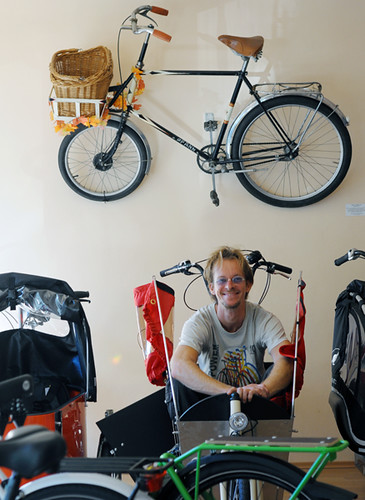
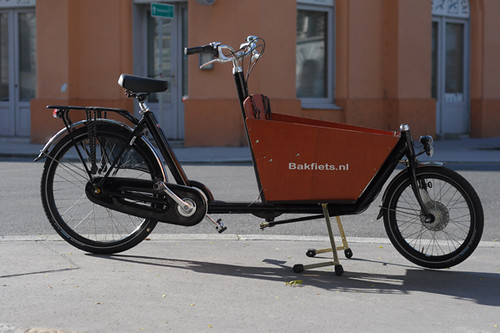
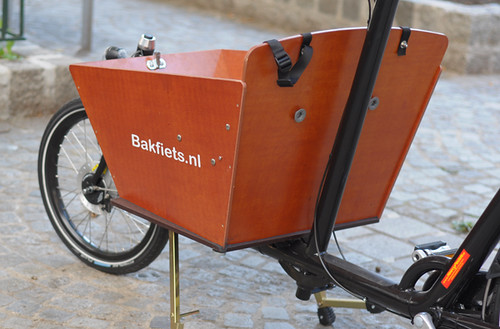
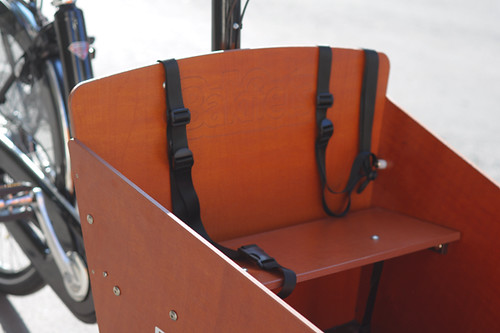
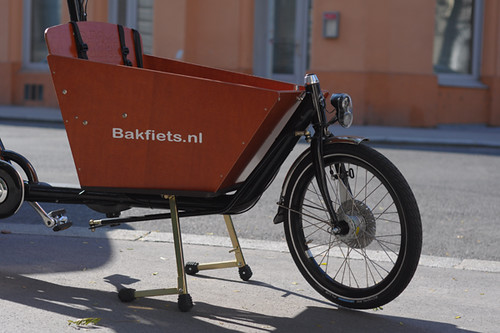
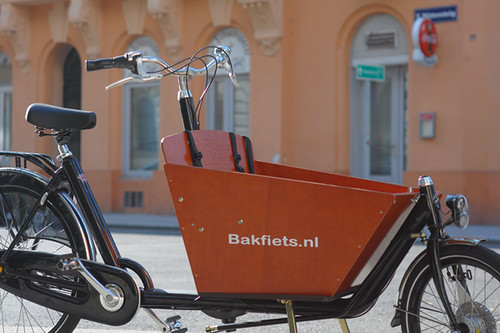

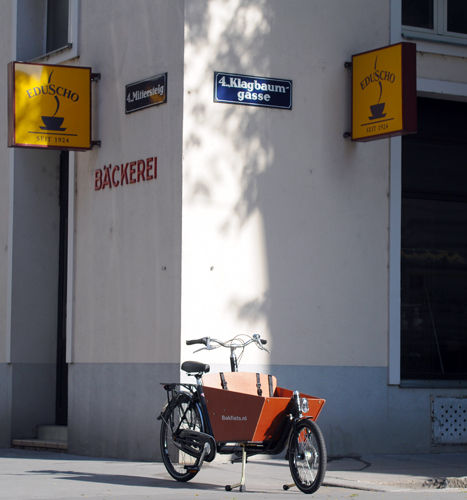
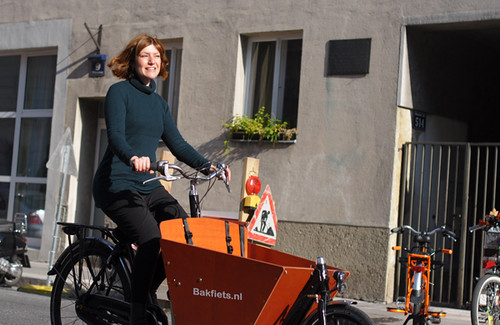
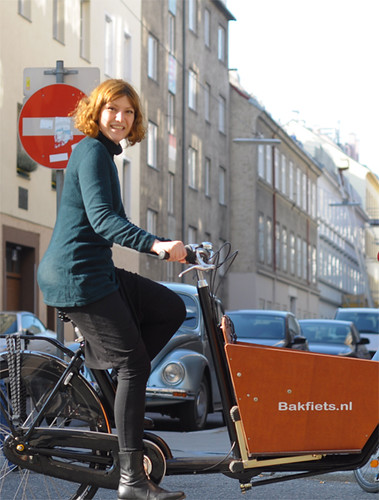
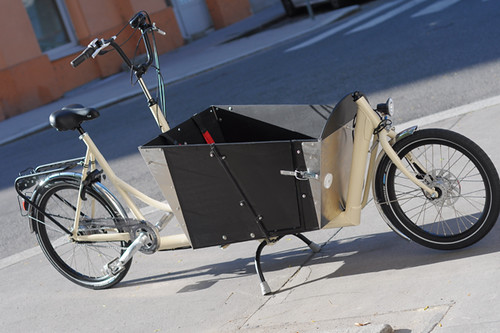
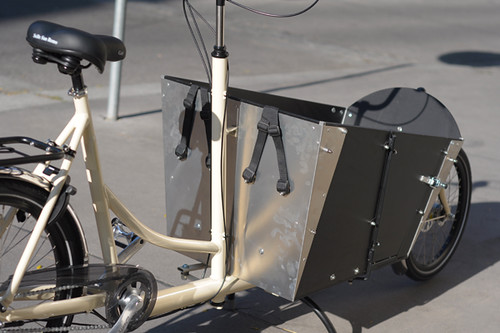
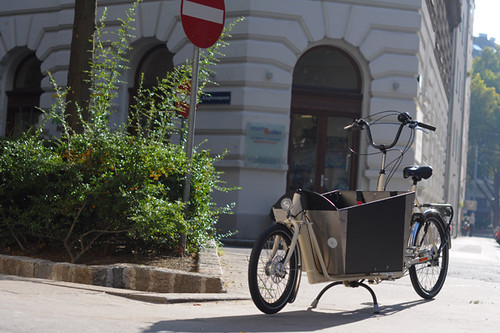
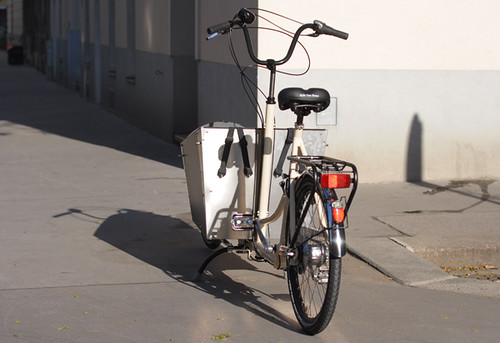
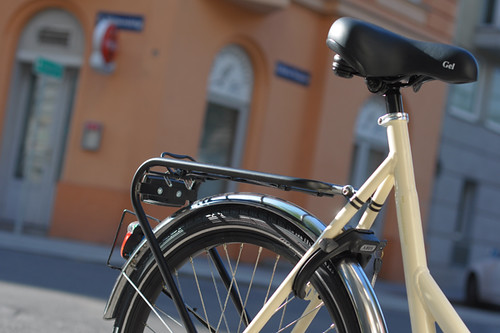
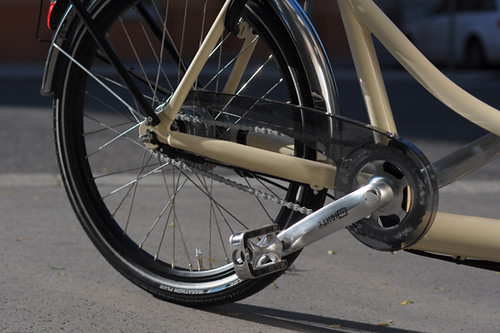

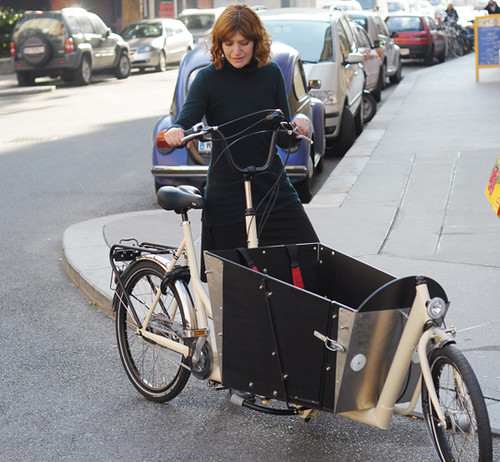
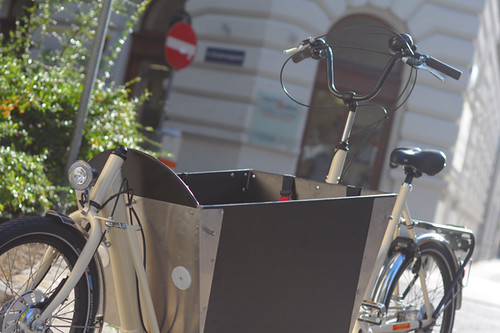
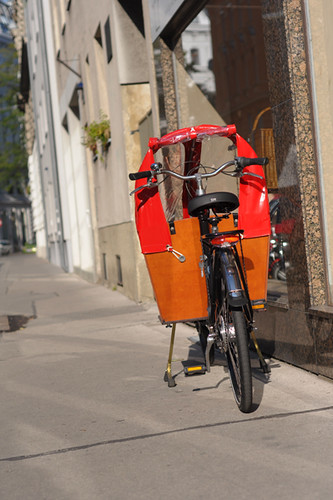
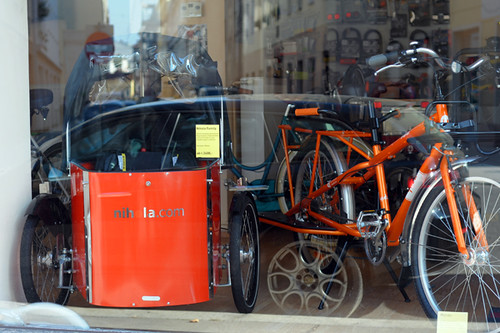
AFAIK, Bakfiets and Workcycle both rely on Azor made frames, while Babboe is chinese stuff, of a lower quality.
ReplyDeleteVery interesting post! :)
ReplyDeleteSteve
Having ridden one of the workcycles longer bakfiets around Amsterdam for a week with my kids, I definitely agree with your assessment. After the initial "woah, this is a long bike" impression, I got used to it, and it felt effortless to carry my two kids and their gear around. My only issue at 6'5" was that the theft-prevention chain they had installed on the rental bike's saddle prevented it from reaching tall enough. it's also worth mentioning that the seat angle is VERY relaxed.
ReplyDeleteThe funny thing is that here in the US, if you have a bike like this, you are on the fringe and clearly identified as a bike-person. In Holland, you were merely identified as someone who probably had to carry stuff around. yeah, they are still expensive over there, but compared to the cost of a car and all that pricey european gasoline, it's not a luxury item.
nice write up thanks.
You might consider carrying a small magnet to resolve those is-this-made-of-steel questions.
ReplyDeleteDo you have any close-ups of the Bakfiets' steering mechanism where it attaches to the fork?
ReplyDeleteThe bakfiets.nl two-wheeler may be based on the 1930s cargo bikes but its specific shape was designed in 2000 by Maarten van Andel, an engineer who wanted a "vehicle" to ferry his children around in Amsterdam. The design was patented in 2003 and a licence to build and sell these bikes was issued to Azor in Hoogeveen, Holland. The bakfiets.nl company is registered at Azor's domicile. Also the Workcycles bakfietsen are built by Azor. According to the commentary in one of the videos on bakfiets.nl's website the frames are made in Belgium, possibly by Achielle's parent company Dija-Oostcolor who also make other Azor frames.
ReplyDeleteInterestingly, Achielle also recently introduced a bakfiets along these lines:
http://www.achielle.be/NL/longachielle.php (Dutch only for now)
The technical specs are rather similar to the bakfiets.nl. The box is aluminum.
I have no idea who makes Babboe's bakfietsen.
I would have liked to see the mechanism that steers the front wheel.
ReplyDeleteThanks for the lovely post, I have not heard of Christiania two wheeler cargo bike before, but it looks fantastic.
ReplyDeleteDo any of the readers have experience with the Babboe two wheeler? I am particularly interested in how it how it holds up over time and if you can safely fit three children in it. Thanks for any info! Babboe is the only cargo bike available in my area, they do not sell bakfiets.nl or Christiania models close to where I live.
I rode the Bakfiets.nl bike at Clever cycles several years ago, and had the same reaction as you- "different, but manageably so"
ReplyDeleteI don't really have a need for a cargo bike, but ever since that test ride, I've had the desire for one.
Did you test any of them loaded? I didn't really either, and I wonder if there would be a big impact from a "dynamic load" (AKA squirming person).
It's worth noting that the Bakfiets.nl Cargobike, while executed in "classic" warm wood and (usually) black steel, is a contemporary design, quite novel upon introduction in about 2000 as suitable for child transport and featuring a deep step-through, single tube frame design. Other kids-in-wood-box long johns are pretty much derivative of Maarten van Andel's decade-old Bakfiets.nl Cargobike design.
ReplyDeleteWorkCycles sells and exports, but does not manufacture, the Bakfiets.nl Cargobike. Bakfiets.nl has a contractual manufacturing arrangement with Azor; Azor makes them solely for Bakfiets.nl. There are a lot of copies, some with meaningful innovation and integrity, but most pretty shameless attempts to ride on the success of the original while cutting corners on quality. Some copies have been legally blocked from entering the Netherlands, compelling their makers to dump production into emerging markets.
The bakfiets.nl cargobike (which everyone calls just a bakfiets, confusing the identity question) feels like a brompton largely because both have very low trail steering (<30mm). Makes a lot of sense for bikes that bear loads up front, whether the load is coupled to the fork as in a porteur or to the frame as in a bakfiets or brompton. The Bullitt and some other long-johns have high trail steering, which hurts their low-speed stability but makes them feel more familiar at speed to people who ride higher trail bikes regularly, particularly sport bikes with steeper seat angles so the hands are weighted.
Re the Christiania 2-wheeler, specs vary, i guess as they are assembled in lower volumes? I was surprised to see dynamo lights and a rack (and a little door!) on your specimen, things the version we have in stock sadly lacks. Yes, the frame is aluminum. Lighter but a lot less stiff. Contrary to your observation, I believe the Bakfiets.nl Cargobike will accommodate a shorter rider than the Christiania.
The ST on the Christiana is actually longer than the Bakfeits'.
ReplyDeleteHere's a question: why would anyone without a child choose a box bike over the other cargo offerings? I can't see a circumstance in which the extra weight is compensated for by mechanical efficiency or carrying capacity.
Of all the cargo bikes you have tried so far, which do you prefer?
ReplyDeleteSounds like it is the bakfiets.nl...
Thanks for the post!
ReplyDeleteThe Christiania 2-wheeler is, indeed, an aluminum frame and, yes, it is hard to find information on it. This is mainly do to the fact that Christiania's reputation was built on the trike (first produced for consumer use in 1984) and therefore, most of their attention is paid to their 'first born'.
One major difference worth noting in Danish vs. Dutch cargo bike culture is the fact that, in general, the Danes prefer trikes - part of me says that it has to do with the Danes' pace of life; they are never in hurry to get anywhere, and the trikes are, on the whole, a slower-paced ride than the two-wheeled bakfiets. Couple that with the foundations of Danish design - simple, classic, and utility-based - and it is easy to see why the Danes like the three-wheeled bikes with their clean lines, simple construction, and huge, useful cargo box.
(http://en.ddc.dk/ddd2010-11/winners/christiania-bikes)
The two wheeler has been around in Denmark for three years and we have actually released a few into the wild in the States over the past 6 months and the response has been fantastic.
But rumor has it that a new model is in the works - just sayin'...
philippe said...
ReplyDelete"AFAIK, Bakfiets and Workcycle both rely on Azor made frames, while Babboe is chinese stuff, of a lower quality."
As I understand it, Azor makes many of its frames in China nowadays as well. Where did you get the info re Babboe?
Metrofiets (http://www.metrofiets.com) in Portland, OR makes Bakfiets-like long-john bikes. They build their frames from chromoly in-house.
ReplyDeleteThey offer lots of options including pallets instead of cargo boxes. They've also done some cool custom jobs such as the Beer bike and the shop bike.
While I don't own a cargo bike I'm told by those who do that something like a Stokemonkey is very helpful, especially if you have to go up hills.
For comments on Babboe quality see here:
ReplyDeletehttp://www.bakfiets-en-meer.nl/2008/07/11/roundup-reviews-of-various-family-transport-bikes/
May be biased but the general trend is visible. You get what you pay for.
As for Azor's frame sourcing, in this video (from regional TV) the build of a bakfiets is shown, with commentary in Dutch - sorry - which says at about 40 secs into the video that the frame is sourced in Belgium.
http://bakfiets.nl/nl/zie-in-actie/11/
Azor's lugged steel frames are all made in Belgium. The aluminum frames mostly come from China, but not all.
And to answer questions about the steering linkage I think we need not look further than one of your own photos:
http://www.flickr.com/photos/lovely_bicycle/6264353468/in/photostream
It's a ball joint like a human shoulder.
Azor frames come from China and Belgium depending on the model. As far as Babboe, i've built one up here for a customer because they needed cheaper shipping since they live in Kakastan and the babboe splits in half.....it needed extensive modification to be acceptable. needless to say we wont sell another one. Great review!
ReplyDeleteMontrealize - Yes, I think the bakfiets would be the one for me. Not that I really need it!
ReplyDeleteGround Round Jim said...
ReplyDelete"Here's a question: why would anyone without a child choose a box bike over the other cargo offerings? I can't see a circumstance in which the extra weight is compensated for by mechanical efficiency or carrying capacity."
For me, it's mainly the (perceived?) convenience of being able to place stuff into a box, as opposed to having to secure it to a platform.
Now, if the Maderna Truck I reviewed earlier came with a built-in box instead of a platform, it would be a tough choice.
But how much extra weight is that plywood box anyway?
I think the more classic Dutch bakfiets is actually this trike: http://www.flickr.com/photos/mindcaster-ezzolicious/4948861571/
ReplyDelete:)
Nice to know that if I do end up renting the bakfiets.nl bike for some cargo errands, it shouldn't be hard to adjust to.
todd said...
ReplyDelete"It's worth noting that the Bakfiets.nl Cargobike, while executed in "classic" warm wood and (usually) black steel, is a contemporary design, quite novel upon introduction in about 2000"
Okay, of course I have no photographic proof when I need it, but I am very certain that I've seen vintage (as in early 20th century) bakfiets-like cargo bikes.
Might Frits have something to say about this?..
about 5 pounds for the three sides of 9mm thick marine-grade ply
ReplyDeletePlywood is heavy and that's a lot of plywood that one would be schlepping around everywhere. Unless, of course, one has other bikes, which then reduces the utility of and justification for a box bike.
ReplyDeleteIf you have a big box to throw stuff in, that's great, but really it's about the load you need to carry. A 2x8 or ladder isn't going to fit nicely, but a box or child is.
You already don't have a car and have managed to deal with carrying issues with bags and panniers. All I'm saying is this isn't a great design for places with hills, narrows passageways, mixed terrain or, gasp, sidewalk riding.
I'm noticing a bit of a reality check from those who've mis-read their needs for a box bike. They're down-sizing or using other bikes for day-to-day stuff.
The biggest enemy of a big, heavy cargo bike is the desire of the rider to utilize it properly, imo. An e-assist would partially solve the usability issue, but then it begs the question: is this thing a bike after all?
Are you sure you want your blog to go in the direction you are taking it? It seems your blog has become a product review aka advertising space. It used to be so interesting. --Wayne
ReplyDeleteFor kicks I weighed the little stack of plywood under my bed (don't ask), about what it would take to build a box. I'd use your scale but you don't have one, so I'll use your method: it's definitely more than my race bike.
ReplyDeleteSo, in other words, it would be like riding a bike with a bike on it. All the time.
Thanks for your impressions! There are a few people in town with bakfiets style bikes, but I am waiting for Madsen to go away before I acquire a new cargo bike. One is a Babboe, and the other guy has a Workcycles one. One thing I am eager to have improved in my cargo-fleet is quality. The Madsen is okay. And I'd probably be fine riding it for several more years... but it's just sort of cheap. Especially since I ride the Pashley by myself. I just like a robust bike.
ReplyDeleteThe other thing I'd like to change about our cargo bike is the centre of gravity. The kids sit up really high in the Madsen, and the seat belt just goes across the waist instead of having the shoulder straps.
It's not insurmountable, I just feel like I wouldn't mind the switch if it were convenient to do so.
yes, Bergreijer was making 2-wheeled "bakfietsen" 90 years ago. They were not for carrying children though.
ReplyDeleteThe Long John principle is at least a 100 years old but mostly in Denmark; the Dutch preferred trikes. I found a page of old photos here:
ReplyDeletehttp://marabakfiets.wordpress.com/inspiratiebron/
where two Dutch examples can be found, from I suppose the 1930s.
The "bakken" were usually custom made; don't forget that Maarten van Andel also tailored his 2000 design to his own specific needs.
Long John aficionados have their own site apparently:
http://www.longjohn.org/
And trikes also came as tandems, as shown on this pic of telephone repairmen in Amsterdam from December 1940 (WW3, no cars):
http://www.nuentoen.nl/fotos/118246/ptt-monteurs-op-bakfiets.html
Some more old transportation bi- and tricycles:
ReplyDeletehttp://www.transportfiets.net/category/bakfietsen/page/4/
If you wonder what Hoofdstedelijke Kattenbakcentrale means: they delivered cat litter in Amsterdam. The peat based stuff, not the clean modern product available from supermarkets.
(I noticed on longjohn.org that a certain "Höfi" Höfler in Vienna has a c. 1990 SCO Long John)
We saw an orange short-box Bakfiets.nl cargo bike parked at the local independent grocery a week or so back. After spending a moment looking it over admiringly in the fading evening light, Herself and I looked at each other and said (almost in unison) "I wonder if Velouria's ridden one of these yet?"
ReplyDeleteIt looked very well made.
Love to see this review and conversation! I am a bit curious how many of the folks replying here are from the United States vs. Europe...but that is probably a bit off topic...I was surprised that no one mentioned Cetma. Also a US builder based in Oregon he builds much more accessible bikes than Metrofiets and builds using a bi-sectible frame to ease shipping costs...they have a nice ride quality with slightly quicker and tighter steering than my Bakfiets.nl but very ridable.
ReplyDeleteWayne - My blog focused on product comparisons from the moment I started it. That was in fact why I started it - I was choosing what bike to buy and trying to understand more about how they were manufactured and what the differences were. See the early posts from 2009. If this is not up your alley, no worries. But it's incorrect to think of this as a new direction.
ReplyDeletePersonally, I greatly appreciate your honest and straightforward reviews of different bikes as well as the articles on cycling and what cycling is like for a woman, as all of my cycling friends are men (and tend towards racing bikes, in which I have no interest). So, thanks!
DeleteFrits - Thanks for the information and links, and also apologies, because I did not see your first comment initially!
ReplyDelete"the bakfiets.nl two-wheeler may be based on the 1930s cargo bikes but its specific shape was designed in 2000 by Maarten van Andel, an engineer who wanted a "vehicle" to ferry his children around in Amsterdam."
This makes sense entirely.
I guess by "vintage bakfietsen" I mean that I've seen front load box bikes that resemble this one (as opposed to a longjohn which has only the frame and is shaped differently). And yes, they were delivery bikes, not for kids. But then I am not looking to transport kids, so this is a moot point for me. So while the bakfiets.nl bikes are a distinct design invented 11 years ago, it is also correct to say that the basic design is old.
Oh and yes, Höfi is Wolfgang. I tried to ride that longjohn a year and a half ago. He has loads of cool stuff like that in his personal collection.
Ah, voila: This is like the older 2-wheeler bakfiets I've seen.
ReplyDeleteFor the mechanically pedantic, the ball joint on the ends (both front and back) of the Van Andel bakfiets cargobike steering linkage rod is called (in North America) a "heim joint":
ReplyDeletehttp://en.wikipedia.org/wiki/Rod_end_bearing
And for a few more old photos:
http://www.bakfiets-en-meer.nl/2010/02/22/the-inventor-of-the-bakfiets/
Ground Round Jim:
ReplyDeleteThe weight of the plywood box on a Bakfiets.nl cargobike may be significant compared to a racing bike, but I doubt it's a very large percentage of the total weight. I haven't weighed mine, but I recall seeing estimates for the whole (long) cargobike, including the box, of about 100 pounds. And yet, if I'm going to a grocery store for just a few items, all of which would fit easily in a single bag on my other bike, I always take the bakfiets (unless my wife has taken the kids somewhere). It is slower, but I don't care about that. Being able to toss a a grocery bag into the box, and feeling confident that the ring lock is adequate protection from theft (it's eight feet long and weighs 100 pounds, after all), it is far, far more convenient than using any other bike for the purpose, even my Brompton.
Sure, I don't have any big hills to climb on my way to and from the grocery store, but that's true for lots of people in North American cities. Not everyone is more concerned with effort and speed than with other forms of utility and convenience.
I just like saying, "Bakses and bakses!" Can't stop really. : )
ReplyDeleteGR Jim - Even if I were to get a longtail, I'd want there to be a box on it. So the plywood/weight factor would remain the same.
ReplyDeleteAnd as far as weight, for me the difference between, say a 60lb bike and a 100lb bike is marginal, since I already cannot lift the lighter version.
Wait, you said "perceived".
ReplyDeleteIf you "want" a box, hypothetically get a box. There isn't a real need for one, including "convenience". Since you haven't tested cargo bikes with different loads you can't begin to imagine what bike works for what, even though a lot of us have tried to tell you.
You missed my meaning about weight - the difference between a 60 lb. bike and a 100 lb. bikes isn't "marginal" on a hill. Go ahead and long term a Bak and ride it on a hill; your knees will over ride your brain within a couple of minutes.
Honestly, this box obsession isn't grounded in reality. Here's a test: take an oversized painting, like 6 x 8 feet, one you've been working on for a long time, and try to transport it 10 miles through Boston.
Merlin, you've taken what you wanted out of what I said and ignored the rest. It's not about the weight per se, it's about the weight that can't come off and a Bak's inability to climb well.
Question for you: how far do you ride your Bak on flat terrain? A lighter, more efficient bike extends your range with less effort. Horses for courses, as always.
Jim -- Which of your comments did I ignore? Would you care for me to address this oversight?
ReplyDeleteDo you actually use a box bike? Because the "box obsession", as you put it, is certainly grounded in reality. I toss all sorts of things in the box of my cargobike that would easily slip and fall off a platform with no walls, requiring them to be secured to the bike in some fashion. Bags of groceries, for instance, or large canisters of flour from a bulk foods store (big enough that they wouldn't fit in any panniers I've ever seen). Without walls on the box to contain my cargo, it would be a big nuisance securing everything on many of the trips that I make, and that cargo frequently shifts around, so let's not pretend that everything stays put if I just set it on a flatbed. Whether or not you'd want one does not change the fact that a box has real utility, and there are people who value that utility more than they value the marginal increase in efficiency they would see from the decrease in weight.
As for the difference in weight, Josh Boisclair stated earlier that three sides of the box weigh "about 5 pounds", although he didn't specify which sides, or which size bakfiets. Let's double that, and say the sides of the box weigh 10 pounds. That makes 90 pounds of bike, and it's fairly pointless to count just that, and not the cargo. My typical load is at least 80 pounds. It's not trivial, but I can climb short hills without an enormous effort. If I actually lived in a non-flat city, I would certainly add at least two teeth to the rear cog, possibly four. I'm not sure when I would spin out while going too slow to keep balance, but I'm nowhere close to it with the current gearing. If I still lived on Cliff St in Arlington Heights, I'd probably want a different cargo bike, but I'm confident that it wouldn't have been a problem in any of the numerous other places I've lived in the Boston area. Having other bikes available, I would certainly make different choices some of the time if I had significant hills to traverse.
As for distance -- I have ridden the bike loaded about 50km in snow on one occasion. I can get all the way to the edges of the city and back in a couple of hours. Doing so makes me ever-so-slightly tired, unless there's a strong headwind, which quickly overwhelms the weight of the bike in terms of the energy required to move it. When there's little wind, I really don't have to put much effort into it to keep the bike moving at a satisfactory speed, but that speed is probably unacceptably slow for someone who prefers to ride a racing bike. Horses for courses, as you say. I take both my kids to school every morning, and then return home with about 80 pounds less to propel. Sure, I notice the difference, but only when there's no wind, and the difference in the time I take for the trip loaded vs unloaded is undetectable.
I don't give a rat's ass that the "extra" weight of the box means I take five or even ten minutes more to get to the garden center 16km away. I do care that I can fill up the box with an assortment of plant life and odd-shaped objects without having to worry about how to secure them without crushing anything.
http://www.flickr.com/photos/mydutchbike/5553202969/in/set-72157626209279047
ReplyDeleteGR Jim - By "perceived" I mean that I recognise that the sense of utility derived from a box is subjective to me. But I nonetheless have that preference. If you recall, even with the Urbana bike I was saying that I would want to bolt a huge tub to the rear rack.
ReplyDeleteRe transporting paintings: I would put it into a canvas box, which I always keep for this purpose, after which I would feel comfortable transporting it through Boston traffic. I would actually feel more comfortable if it were secured to the top of a box: In the event the bike flips to the side it would be more likely to survive.
I would not get a 100lb bakfiets if I planned to travel through seriously hilly areas. The Christiania, however, is considerably lighter - so maybe that would be my solution.
Technically it'd be "bakken en bakken".
ReplyDeleteWell, in Dutch.
ReplyDeleteBut it's "bakses" in Denglish.
Merlin, my box obsession comment was directed at V, the author of this blog, not you, a reader.
ReplyDeleteYou ignored the meaning behind my words: I asked who without a child needs a bakfiets. You just proved my point.
Just because you "can" go 50km doesn't mean you want to regularly.
Again you missed my point about efficiency as it relates to tiredness.
You can build an argument around box bikes all you want, but this isn't a conversation if you don't pay attention to what I write.
For climbing really steep hills, I would think a tricycle would work best, since you don't need to steer for balance. That way, you could have almost arbitrarily low gearing. Of course, at some point, one would get frustrated about not moving fast enough (depending on personality and experience) or possibly have a drive wheel (or wheels, depending) start slipping.
ReplyDeleteSo you're proposing to put giant paintings in a box to put ON TOP of a box so it can slide around and overhang into traffic and the door zone at once?
ReplyDeleteMy point is proven: this is the wrong tool for that job.
Well, so what if I have a box obsession? I am comfortable with that label.
ReplyDeleteThe way I see it, all this just goes to show it's good to have different models on the market. I've noticed that people get even more passionate/debateful/defensive about their preferred version of cargobike than they do with regular bikes. When I very honestly reported that I couldn't ride the Bullitt after several tries, I got emails from Bullitt-lovers who were angry and suggested that I must just not be able to ride a bike at all and should stay away from cargo bike assessments - cause a Bullitt is so clearly *the* best, and so on.
I don't know, maybe when one pays $5K per bike, or however much these things cost in the US, it's especially painful if others question the bestness of your choice. But to me it's the more options the merrier. Hard to argue about preferences.
In a way the angry Bullitt riders have a point: I'll bet you would be able to ride one now and you should test them laden. It's a UTILITY bike, not a joy ride.
ReplyDeleteI have no issue with preferences, but I have an issue with those who say anything is the best.
As for the experience behind the choice that determines a preference I'll say it again: it's all a pipe dream until you plop down the credit card.
Reality has a way of messing with preferences, but spinning rationales based upon subjective preferences that can and will change, as you have proven, is silly.
Ground Round Jim: you're making big blanket statements that all you really need for any job is a longtail, and that it is always better than a box-style cargo bike, which is not true.
ReplyDeleteHonestly, there is a lot of convenience to just having an open container on your bike that you can toss stuff in (even if it's just a crate on the front rack of a 'regular' bicycle), rather than having to find some way to secure it to the bike, even if the bicycle is then slightly more awkward to handle, or slightly less efficient. Also, not everyone who owns a box-style cargo bike needs to ride it up huge hills for 10 miles, often it's perfectly sufficient for the needs of the person who owns it.
It's fine if a longtail fits *your* situation better, you get to choose the bicycle which fits what you need and want. Longtails are great for a lot of things, and I see way more of them here in Portland than box-style cargo bikes. But you're getting to the point of evangelizing here. Tell us what's great about your longtail, but don't start telling people how silly they are for having different preferences than you.
GR Jim - I've tried the Bullitt again very recently, and I've tried it laden. My impression remains unchanged from the test ride report I posted earlier. It's possible that after weeks of practice I might become comfortable using it (comfortable = willing to ride it for real). By contrast, I felt comfortable using the bakfiets and the longtail "truck" pretty much immediately. I think that's a difference worth noting.
ReplyDeleteportland, no I'm not. I'm asking why a box bike is preferred by V. Yes, there's a difference. I'm asking her preference, not yours. Respond if you want.
ReplyDeleteI don't care what a person rides, as long as it works.
How would you know how a bakfiets climbs - you've never ridden one. Nor a longtail, nor...anything cargo. Honestly, how do you think you can even begin to answer a cargo question when you have normal bikes? Your presumption about what they can and can't do is tremendous and lacks a) personal experience and b) deep knowledge of bikes.
You might want to read my above comment before you reply again.
That's funny, you talking about evangelizing, your history is all about proselytizing in a religious and bicycle dogmatic way. Too close to your territory I guess.
Absolutely.
ReplyDeleteYep, that is my past, and that's why I'm sensitive to it now. Thanks for resorting to insults to win the argument, I appreciate that.
ReplyDeleteAlso, I wasn't trying to argue about what different types of bicycles could do, I was making a comment about your discussion on this post so far. But yes, I do have experience riding a bicycle with an open container on the front, so yes, I do know from experience that it's convenient. Thanks. I also wasn't commenting that a box-style bicycle was good at climbing, I stated that some don't need it to be. That is undeniably true.
ReplyDeleteYou can be rude and dismiss people all you like because you know more than everyone, but it doesn't mean we're going to take you seriously.
I apologize to in advance for what I'm about to write, but he's really asking for it.
ReplyDeleteportland, so you really want more? Ok, you're going to get it.
Your proselytizing past is the same as the present. Every other post in your blog starts with "We should". Own it.
I can't help what spins around in your brain to try to make sense of what I said, but I will repeat what I said once again: I was conversing with V, not you. There are subtexts that you chose to butt in on. Now you want to discuss a tiny little box you put on your front rack and equate that to a VERY LARGE CONTAINER that is on the bakfiets? Are you freaking serious?
Did you read the comments and try to extract some info from it or did you come in with a pre-set agenda? I don't even mention longtails here so it must be the latter.
How are you going to carry a 6 FOOT BY 8 FOOT STACK OF PAINTINGS in your little shoebox? You blog about carrying things like a twelve pack!
Now you are just trolling. Who are "we" to not take me seriously? You and...? There you go with the "we" business.
Who is being rude without reading and understanding? See, that's what people say when you tell them they don't understand what's being written. It's equivalent to whining, "wah, he doesn't start every sentence with 'I disagree'".
As for not taking me seriously, why the hell should I care what you think? I've told you numerous times I can't take you seriously but here you are, baiting me.
Ridiculous, a shoe box on your front rack and that makes you a cargo specialist.
Ball's in your court.
Oh God... Guys - if you can continue this without insults that would be great. If not, please don't go on. I can't edit your comments, I can only approve or remove them. It would be a shame to remove everything, as there is some good info burried in there.
ReplyDeleteI never claimed to be a cargo specialist, and I am again not claiming that a box-style cargo bike is the solution for everyone. I made a simple statement that having an open container on the front of the bike can be convenient, and you're getting angrier and angrier and hurling more insults. I'm not participating further in that kind of discussion, because I'm not trying to win anything here, I'm just trying to participate in the discussion, but I've suddenly ended up in a fight with you. I'm sorry if I inadvertently started it, I didn't intend to, and I apologize to Velouria for this thread. I'm done, thanks.
ReplyDeleteI'm in love with mine, a 'preloved' Bakfiets.nl which I've owned for several months.
ReplyDeletehttp://www.cyclorama.net/blog/ramblings/straw-man/
I've a gallery here too: http://www.facebook.com/media/set/?set=a.213232702051276.49741.100000936421951&type=3&l=9e0d45fa69
Jim,
ReplyDeleteI pound the living day lights out of my bakfietsen, and thr only barriers I have encountered to its use are the width of local trains, unfriendly roads, and my own initial timidity to use it properly. The weight of the bike is trivial relative to the utility of the bike. I ride everywhere wiyh a bug-out bag's worth of stuff amd still have plenty of room for a full load of groceries and my kid. Weight weines won't get it until they've tried it. Seriuosly.
http://www.flickr.com/photos/bardlee/4037815182/in/set-72157622633474849
ReplyDelete